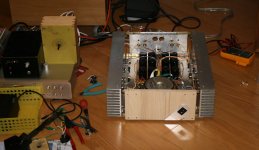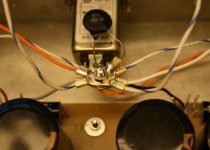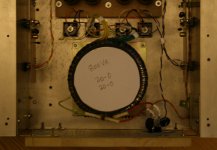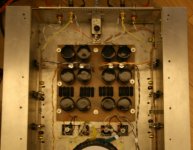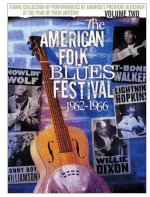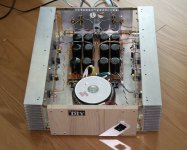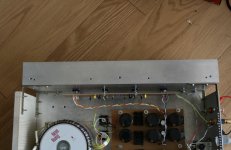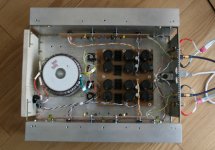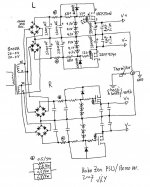Zen Mod said:why is that CD on donut's (dog'h'nuts) top?
Actually, it's not a CD, but DVD titled "The AMERICAN FOLK BLUES
FESTIVAL 1962-1966" (Part 2).
I took it out of the player and put it on the donut for a temporary
parking. Forgot removing it when I took the picture.

Babowana said:I tried listening. The sound is great.
Eeee . . . somewhat hummm . . .
When pre disconnected, no hum.
When one channel connected (either left or right), no hum.
**But, when both channels connected, some hum . . .**
What is the most probable reason? Thanks.

Babo, check for signal ground connection between L-R channels of your pre and try to separate them to a star ground.
Your transformer is probably inducing a ground loop noise
between the amp input grounds, the ground cables going back
to the preamp and closed by the connection between the
preamp output grounds. Try breaking the loop with a 10 ohm
resistor between cable ground on one channel and circuit
ground and see what you get.

between the amp input grounds, the ground cables going back
to the preamp and closed by the connection between the
preamp output grounds. Try breaking the loop with a 10 ohm
resistor between cable ground on one channel and circuit
ground and see what you get.
Blues said:Babo, check for signal ground connection between L-R channels of your pre and try to separate them to a star ground.
Nelson Pass said:Your transformer is probably inducing a ground loop noise
between the amp input grounds, the ground cables going back
to the preamp and closed by the connection between the
preamp output grounds. Try breaking the loop with a 10 ohm
resistor between cable ground on one channel and circuit
ground and see what you get.

Yes, the pre's output gound is common at the output point.
Yes, the power amp had separated circuit grounds between
left and right channels.
Based on your advices, I made a drawing of the gounding map
on the paper. Yes, it was clear that the amp's separated star
grounds were the mistake.
When I tried the loop break with 10ohm resistor on the left channel
only, the left channel got hum while the right channel appeared quiet.
When I tried the loop breaks on both channels, both channels
got hum.
Finally, I tried a common star ground instead of the separated
for the power amp. Wow wow, all noise disappeared!
Thanks lot for the advices, Papa and Blues ^^.

Attachments
OK, this stereo version has somewhat different things, compared
with the mono-block construction (in another old thread). Let's
have a look.
In this version, I use one transformer, 2x(20-0)V secondaries at
total 800VA. This transformer back-ups both channels. The size of
800VA is big enuf and quiet in service. Quite good Chinese make
which I like for my DIY audio, and the price is low. From this, I
get +/- rails of about 18V--i.e. zener reference voltages at the
gates of the regulation MOSFETs are +/-22.5V. And, bias is set at
1.5A.
The bridge rectifiers are of 1000V/25A rating. Each two bridges
covers each channel.
I use the two-pole power on/off switch where I have NTC
thermistors at each pole, suppressing the turn-on in-rush current.

with the mono-block construction (in another old thread). Let's
have a look.
In this version, I use one transformer, 2x(20-0)V secondaries at
total 800VA. This transformer back-ups both channels. The size of
800VA is big enuf and quiet in service. Quite good Chinese make
which I like for my DIY audio, and the price is low. From this, I
get +/- rails of about 18V--i.e. zener reference voltages at the
gates of the regulation MOSFETs are +/-22.5V. And, bias is set at
1.5A.
The bridge rectifiers are of 1000V/25A rating. Each two bridges
covers each channel.
I use the two-pole power on/off switch where I have NTC
thermistors at each pole, suppressing the turn-on in-rush current.

Attachments
The picture is a bit out of focus due to my instable hand shake.
Behind the bridge rectifiers, the first group of caps is formed with
audio-grades (?) of 22,000uF/35V. Then, 0.5ohm/5W wire-wound
resistors are following to reduce the ripples, and the second group of
caps, again of 22,000uF/35V, is following to complete the whole
CRC filter.
The last group of caps is formed with audio-grades of 33,000uF/35V.
This part woks as signal AC ground, pursuing perfect AC ground.
And, **the star ground** is at the end of PSU board.
Left/right channel grounds of PSU coming to this joint.
Left/right (-) speaker terminals coming to this joint.
Left/right input ground lines coming to this joint.
Left/right amp circuit grounds coming to this joint.
And, the star ground is connected to the safety earth (and chassis)
via 10ohm/5A NTC thermistor.
Compared with the mono blocks,
differences are that the sizes of the caps forming CRC filter
are reduced from 33,000uF to 22,000uF and the resistors are
replacing the air coils. Based on these changes,
what performance/sound difference . . . ?
Unluckily, I don’t feel any noticeable difference ^^.
The sound is still simply great!

Behind the bridge rectifiers, the first group of caps is formed with
audio-grades (?) of 22,000uF/35V. Then, 0.5ohm/5W wire-wound
resistors are following to reduce the ripples, and the second group of
caps, again of 22,000uF/35V, is following to complete the whole
CRC filter.
The last group of caps is formed with audio-grades of 33,000uF/35V.
This part woks as signal AC ground, pursuing perfect AC ground.
And, **the star ground** is at the end of PSU board.
Left/right channel grounds of PSU coming to this joint.
Left/right (-) speaker terminals coming to this joint.
Left/right input ground lines coming to this joint.
Left/right amp circuit grounds coming to this joint.
And, the star ground is connected to the safety earth (and chassis)
via 10ohm/5A NTC thermistor.
Compared with the mono blocks,
differences are that the sizes of the caps forming CRC filter
are reduced from 33,000uF to 22,000uF and the resistors are
replacing the air coils. Based on these changes,
what performance/sound difference . . . ?
Unluckily, I don’t feel any noticeable difference ^^.
The sound is still simply great!

Attachments
Babowana said:
Actually, it's not a CD, but DVD titled "The AMERICAN FOLK BLUES
FESTIVAL 1962-1966" (Part 2).
I took it out of the player and put it on the donut for a temporary
parking. Forgot removing it when I took the picture.

Babowana, could you look up if that festival was recorded at Newport?
Steen
Check up the picture.
Recorded during Europe touring.
I grab the spirit and humor melted on the legendary blues music
recorded in this DVD. Willie Dixon plays "Nervous."
I highly recommend this DVD!
Your F4 will be pleased to play!
^^.

PS. I have only Vol.II
Recorded during Europe touring.
I grab the spirit and humor melted on the legendary blues music
recorded in this DVD. Willie Dixon plays "Nervous."
I highly recommend this DVD!
Your F4 will be pleased to play!
^^.

PS. I have only Vol.II
Attachments
Thanks Yeah, its that one! Just looked up the other volumes. Its a 3 volume series, with all the great old Bluesmen. Even Skip James is on Vol.3. He was the one I was looking for when asking
Yeah, its that one! Just looked up the other volumes. Its a 3 volume series, with all the great old Bluesmen. Even Skip James is on Vol.3. He was the one I was looking for when asking Very interesting DVD set. I also noticed several other Willie Dixon classics, which ofcourse is no surprise considering that he wrote a lot of hits for Muddy waters and Howling Wulf amongst others.
Very interesting DVD set. I also noticed several other Willie Dixon classics, which ofcourse is no surprise considering that he wrote a lot of hits for Muddy waters and Howling Wulf amongst others.
The song "I cant quit you, Baby" is there It was covered by Led Zeppelin on their first album together with other Dixon songs. In fact Led Zep liked Dixons songs so much that some of the songs on Led Zep 2 based on Dixon songs were claimed to be Paige's own
It was covered by Led Zeppelin on their first album together with other Dixon songs. In fact Led Zep liked Dixons songs so much that some of the songs on Led Zep 2 based on Dixon songs were claimed to be Paige's own
Steen
The song "I cant quit you, Baby" is there

Steen
Back to the amp . . .
It’s hot.
I have kept the power-on for 48 hours, adjusting the output offset near to zero. The heat sinks are hot at about 28 deg C above the room temperature. This means that the heat sink temperature could go up to maximum 60 deg C in the steady equilibrium state in the summer weather. As each gain MOSFET dissipates about 30W, its junction temperature might be estimated as maximum 85 deg C in operation. Therefore, I do not foresee any potential damage of the gain MOSFETs with respect to the heat vs. de-rated power rating.
Believe or not (No logic behind) . . .
I feel warmer and sweeter sound from this stereo version, compared with the mono blocks having bigger heat sinks and lower operating temperature. Probably, the increased heat might be cooking the electrons warmer and sweeter. Here, I do not mean that warmer and sweeter sound implies that the edge sound is rounded off.
Do you believe?

It’s hot.
I have kept the power-on for 48 hours, adjusting the output offset near to zero. The heat sinks are hot at about 28 deg C above the room temperature. This means that the heat sink temperature could go up to maximum 60 deg C in the steady equilibrium state in the summer weather. As each gain MOSFET dissipates about 30W, its junction temperature might be estimated as maximum 85 deg C in operation. Therefore, I do not foresee any potential damage of the gain MOSFETs with respect to the heat vs. de-rated power rating.
Believe or not (No logic behind) . . .
I feel warmer and sweeter sound from this stereo version, compared with the mono blocks having bigger heat sinks and lower operating temperature. Probably, the increased heat might be cooking the electrons warmer and sweeter. Here, I do not mean that warmer and sweeter sound implies that the edge sound is rounded off.
Do you believe?

Babowana said:.................
Do you believe?

it's just that
 is spinnin' faster
is spinnin' faster
Babowana said:Back to the amp . . .
It’s hot.
I have kept the power-on for 48 hours, adjusting the output offset near to zero. The heat sinks are hot at about 28 deg C above the room temperature. This means that the heat sink temperature could go up to maximum 60 deg C in the steady equilibrium state in the summer weather. As each gain MOSFET dissipates about 30W, its junction temperature might be estimated as maximum 85 deg C in operation. Therefore, I do not foresee any potential damage of the gain MOSFETs with respect to the heat vs. de-rated power rating.
Believe or not (No logic behind) . . .
I feel warmer and sweeter sound from this stereo version, compared with the mono blocks having bigger heat sinks and lower operating temperature. Probably, the increased heat might be cooking the electrons warmer and sweeter. Here, I do not mean that warmer and sweeter sound implies that the edge sound is rounded off.
Do you believe?

yep. i beleive. Must be the temp! I can hear it clearly as my A-X's warm up! It takes at least a full half hour to sound half decent
Just in Dixon/Led Zep case
Steen
- Status
- This old topic is closed. If you want to reopen this topic, contact a moderator using the "Report Post" button.
- Home
- Amplifiers
- Pass Labs
- Re-build Babo Zen (Papa's Zen5 w. jfet inputs)
